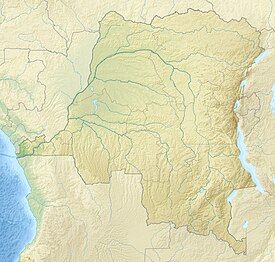
The Olduvai Gorge or Oldupai Gorge in Tanzania is one of the most important paleoanthropological localities in the world; the many sites exposed by the gorge have proven invaluable in furthering understanding of early human evolution. A steep-sided ravine in the Great Rift Valley that stretches across East Africa, it is about 48 km long, and is located in the eastern Serengeti Plains within the Ngorongoro Conservation Area in the Olbalbal ward located in Ngorongoro District of Arusha Region, about 45 kilometres from Laetoli, another important archaeological locality of early human occupation. The British/Kenyan paleoanthropologist-archeologist team of Mary and Louis Leakey established excavation and research programs at Olduvai Gorge that achieved great advances in human knowledge and are world-renowned. The site is registered as one of the National Historic Sites of Tanzania.

The Oldowan was a widespread stone tool archaeological industry (style) in prehistory. These early tools were simple, usually made with one or a few flakes chipped off with another stone. Oldowan tools were used during the Lower Paleolithic period, 2.9 million years ago up until at least 1.7 million years ago (Ma), by ancient Hominins across much of Africa. This technological industry was followed by the more sophisticated Acheulean industry.

Lake Edward is one of the smaller African Great Lakes. It is located in the Albertine Rift, the western branch of the East African Rift, on the border between the Democratic Republic of the Congo (DRC) and Uganda, with its northern shore a few kilometres south of the equator.

The Museum of Natural Sciences of Belgium is a Brussels museum dedicated to natural history. It is a part of the Royal Belgian Institute of Natural Sciences.
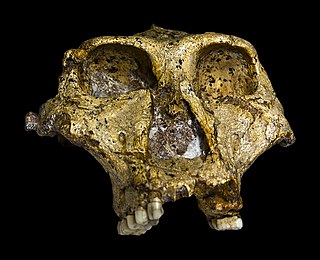
Swartkrans is a fossil-bearing cave designated as a South African National Heritage Site, located about 32 km (20 mi) from Johannesburg. It is located in the Cradle of Humankind World Heritage Site and is notable for being extremely rich in archaeological material, particularly hominin remains. Fossils discovered in the limestone of Swartkrans include Homo ergaster, Paranthropus and Homo habilis. The oldest deposits present at the site are believed to be between 1.9 and 2.1 million years old.
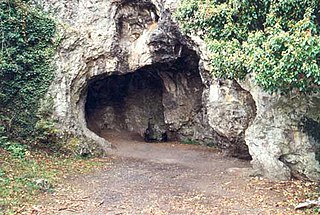
Spy Cave is located in Wallonia near Spy in the municipality of Jemeppe-sur-Sambre, Namur Province, Belgium above the left bank of the Orneau River. Classified as a premier Heritage site of the Walloon Region, the location ranks among the most significant paleolithic sites in Europe. The cave consists of numerous small chambers and corridors.
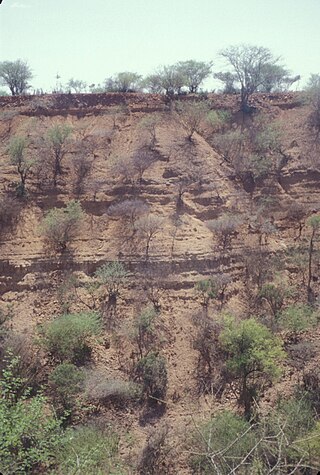
The Kapthurin Formation is a series of Middle Pleistocene sediments associated with the East African Rift Valley. Part of the East African Rift System, it is also an important archaeological site in the study of early humans who occupied the area and left stone tools and animal bones behind. It outcrops in Kenya west of Lake Bogoria and northwest of Lake Baringo in the Kenya Rift Valley, exposed on the surface in a 150 km2 (58 sq mi) area. It also outcrops in portions of the Tugen Hills farther east. The ~125 metres (410 ft) of sediment that comprises the Kapthurin formation represents more than 600,000 years of depositional history. Clastic sediments, tuffs, and carbonate beds, in the Kapthurin give information on past river and lake environments. Additionally, intercalated tuffs and extrusive igneous rocks associated with Rift Valley volcanic activity have allowed for multiple argon–argon dating studies. The high resolution dating enables archaeological studies regarding changing hominin behavior. The Kapthurin Formation has been used to study the Acheulian-Middle Stone Age transition.
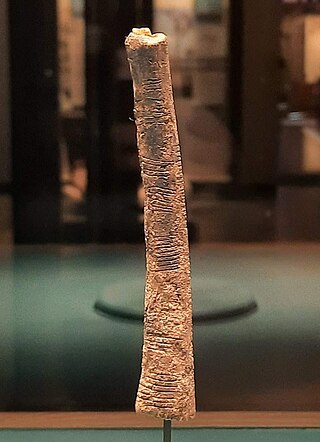
The Ishango bone, discovered at the "Fisherman Settlement" of Ishango in the Democratic Republic of the Congo, is a bone tool and possible mathematical device that dates to the Upper Paleolithic era. The curved bone is dark brown in color, about 10 centimeters in length, and features a sharp piece of quartz affixed to one end, perhaps for engraving. Because the bone has been narrowed, scraped, polished, and engraved to a certain extent, it is no longer possible to determine what animal the bone belonged to, although it is assumed to have been a mammal.

Eartham Pit is an internationally important archaeological site north-east of Boxgrove in West Sussex with findings that date to the Lower Palaeolithic. The oldest human remains in Britain have been discovered on the site, fossils of Homo heidelbergensis dating to 500,000 years ago. Boxgrove is also one of the oldest sites in Europe with direct evidence of hunting and butchering by early humans. Only part of the site is protected through designation, one area being a 9.8-hectare (24-acre) geological Site of Special Scientific Interest, as well as a Geological Conservation Review site.

Jean de Heinzelin de Braucourt was a Belgian geologist who worked mainly in Africa. He worked at the universities of Ghent and Brussels. He gained international fame in 1950 when he discovered the Ishango Bone

Jebel Irhoud or Adrar n Ighoud, is an archaeological site located just north of the locality known as Tlet Ighoud, approximately 50 km (30 mi) south-east of the city of Safi in Morocco. It is noted for the hominin fossils that have been found there since the discovery of the site in 1960. Originally thought to be Neanderthals, the specimens have since been assigned to Homo sapiens and, as reported in 2017, have been dated to roughly 300,000 years ago.
The Semliki harpoon, also known as the Katanda harpoon, refers to a group of complex barbed harpoon heads carved from bone, which were found at an archaeologic site on the Semliki River in the Democratic Republic of the Congo ; the artifacts which date back approximately 90,000 years. The initial discovery of the first harpoon head was made in 1988. When the artifact was dated to 88,000 BCE, there was skepticism within the archaeological community about the accuracy of the stated age; in that the object seemed too advanced for human cultures of that era. However, the site has yielded multiple other examples of similar harpoons, and the dates have been confirmed.
The archaeological site of Shum Laka is the most prominent rockshelter site in the Grasslands region of the Laka Valley, northwest Cameroon. Occupations at this rockshelter date to the Later Stone Age. This region is important to investigations of the development and subsequent diffusion of Bantu-speaking peoples. The site of Shum Laka is located approximately 15 kilometers from the town of Bamenda, and it resides on the inner wall of the Bafochu Mbu caldera. The deposits at Shum Laka include each phase of cultural development in the Grasslands.

The Hohle Fels is a cave in the Swabian Jura of Germany that has yielded a number of important archaeological finds dating from the Upper Paleolithic. Artifacts found in the cave represent some of the earliest examples of prehistoric art and musical instruments ever discovered. The cave is just outside the town of Schelklingen in the state of Baden-Württemberg, near Ulm. Because of the outstanding archeological finds and their cultural significance, in 2017 the site became part of the UNESCO World Heritage Site Caves and Ice Age Art in the Swabian Jura.

The Bouri Formation is a sequence of sedimentary deposits that is the source of australopithecine and Homo fossils, artifacts, and bones of large mammals with cut marks from butchery with tools by early hominins. It is located in the Middle Awash Valley, in Ethiopia, East Africa, and is a part of the Afar Depression that has provided rich human fossil sites such as Gona and Hadar.

Lomekwi is the name of an archaeological site in Kenya where ancient stone tools have been discovered dating back approximately 3.3 million years ago making them the oldest tools ever found.
Alison S. Brooks is an American paleoanthropologist and archaeologist whose work focuses on the Paleolithic, particularly the Middle Stone Age of Africa. She is one of the most prominent figures in the debate over where Homo sapiens evolved and when.

The Goyet Caves are a series of connected caves located in Belgium in a limestone cliff about 15 m (50 ft) above the river Samson near the village of Mozet in the Gesves municipality of the Namur province. The site is a significant locality of regional Neanderthal and European early modern human occupation, as thousands of fossils and artifacts were discovered that are all attributed to a long and contiguous stratigraphic sequence from 120,000 years ago, the Middle Paleolithic to less than 5,000 years ago, the late Neolithic. A robust sequence of sediments was identified during extensive excavations by geologist Edouard Dupont, who undertook the first probings as early as 1867. The site was added to the Belgian National Heritage register in 1976.
Shangchen is a Lower Palaeolithic archaeological site in Lantian County, Shaanxi, China, some 25 km south of Weinan. It was discovered in 1964, and excavated during 2004 and 2017.

The archaeological site of Atapuerca is located in the province of Burgos in the north of Spain and is notable for its evidence of early human occupation. Bone fragments from around 800,000 years ago, found in its Gran Dolina cavern, provide the oldest known evidence of hominid settlement in Western Europe and of hominid cannibalism anywhere in the world.
